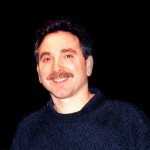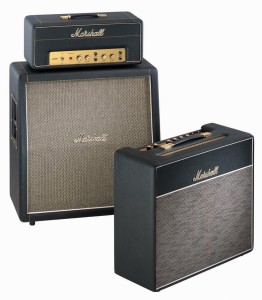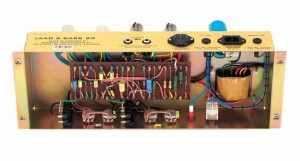 Recently at the past 2004 NAMM show, Marshall formally unveiled its latest line of amplifiers – vintage recreations called the Hand Wired series. For many vintage amp tone enthusiasts (myself included), this was just the move that we had hoped Marshall would someday make.
Recently at the past 2004 NAMM show, Marshall formally unveiled its latest line of amplifiers – vintage recreations called the Hand Wired series. For many vintage amp tone enthusiasts (myself included), this was just the move that we had hoped Marshall would someday make.
As described below, Marshall really spent the time going through the details with the development of the Hand Wired series. From the turret-boards, to the custom-designed and manufactured transformers, to specially developed and tuned speakers – the Hand Wired series was created with a focus on obtaining authentic, pure vintage tone.
MitchColby, senior vice president of Product Development and Support at Korg U.S.A. (Marshall’s U.S. Distributor) was kind enough to answer some questions for us about the new lineup.
LegendaryTones: Can you tell us a bit about the genesis of the new Marshall Hand Wired series? Perhaps who was involved with the team from the early stage of researching the marketplace to those who helped make the final decisions to go ahead?
 Mitch Colby: We had discussed the possibilities of manufacturing hand wired amps for over ten years before actually doing something about it. There were a number of us who were very enthusiastic but the realities of running the company including rapid worldwide growth coupled with increasingly stringent electrical safety legislations forced us to wait. The Limited Edition JTM45 Offset was our first hand wired amp since the early/mid 70’s. The fact that this was only deemed legal for sale in the US and Japan is a good indication as to how limiting the aforementioned legislations had become. Those of us at the US distributor were very enthusiastic for more handwired products to follow due to the incredible response the offset garnered but it didn’t become a reality until Jim Marshall decided that it was a good idea. Once Jim gave the OK his team including Bruce Keir, Ian Robinson and Laurent Veignal did the research, worked with suppliers, made the necessary changes due to electrical standards around the world and recreated the sound of the old amps.
Mitch Colby: We had discussed the possibilities of manufacturing hand wired amps for over ten years before actually doing something about it. There were a number of us who were very enthusiastic but the realities of running the company including rapid worldwide growth coupled with increasingly stringent electrical safety legislations forced us to wait. The Limited Edition JTM45 Offset was our first hand wired amp since the early/mid 70’s. The fact that this was only deemed legal for sale in the US and Japan is a good indication as to how limiting the aforementioned legislations had become. Those of us at the US distributor were very enthusiastic for more handwired products to follow due to the incredible response the offset garnered but it didn’t become a reality until Jim Marshall decided that it was a good idea. Once Jim gave the OK his team including Bruce Keir, Ian Robinson and Laurent Veignal did the research, worked with suppliers, made the necessary changes due to electrical standards around the world and recreated the sound of the old amps.
LT: Were the Vox hand wired AC-30 and Marshall JTM-45 limited edition offsets considered in part to be the “pilots” or market testers for the new Hand Wired series or were there plans already in place to introduce the HW series and put them in production all along?
MC: The Offset was done at the request of Korg USA, the US Marshall distributor. We had requested hand wired amps for years. The AC30 was designed in the US and then production engineered and built by Marshall since they were the exclusive manufacturer for VOX tube amps ever since Korg bought VOX in the early 90’s. The AC30HW could be thought of as a pilot for the Marshall hand wired amps since it was production engineered by the same team.
LT: Marshall historically has implemented a number of circuits and changes for each of its amplifiers through the years such as the Super Lead with the change from shared to split cathode, added filtering, as well as transformer size and positioning on the chassis. How was the decision made to choose a particular or “best” era of a circuit to recreate?
MC: The 18 watt combo and the 20 watt head were copied exactly from totally stock units that are in the Marshall museum. The design team was careful to use similar construction resistors and capacitors as well as transformers that are clones of the originals.
For the Super Lead, it was more difficult since arguments can be made to choose any one of a number of transitional designs. We listened to a number of amps and picked one that we all agreed sounded great. It turned out to be one from 1967 which was a good compliment to the 1959SLP.
In recreating the 18 watt combo, after first deciding that the 1×12 format was our favorite, we quickly realized that the 20 watt Greenback speaker was an important part of the amp’s unique sound. It is interesting to note that we listened to one of our original 18 watters with six different original 20 watt Greenbacks and the difference between the speakers was quite large. After choosing our favorite, which was not surprisingly in the middle of the pack in terms of response, we compared existing Celestion reissue speakers and none of them could reproduce the smooth overdrive the 18 watter is famous for. The closest was a well broken in G12H30 but it wasn’t close enough so we asked Celestion to reissue the original 20 watt Greenback. After a number of well broken in prototypes, a standard was chosen and Celestion will be making them in the UK exclusively for this amp. The speakers will be aged by “pulping” the cone and slightly degaussing the magnet.
LT: Can you provide more details about each of the amplifiers in terms of specifications and circuit decisions that many of the interest vintage amp users could appreciate? (For example, the Super Lead model 1959 reissue has been described as having large transformers, but details on the size and plate voltages coming out of the power transformer would be of interest if you could provide them).
MC: The 1959HW is still being finalized due to the regulations mentioned above. However here are some things that might be of interest:
270k channel mix resistors
100pf cap on Ch 1 Volume control
47k feedback resistor on the 16 ohm tap
Tone network includes 240p, .02 caps and 56k resistor
Cathodes of the first tube are tied together
LT: Can you tell us about the processes for developing some of the new components and parts used within the HW series? For example, some of the transformers in the older original amps were made by Drake. The larger transformers in the 1959 Super Lead were made by Dagnall and I imagine the transformer company selected to make the new models would have to work very closely with Marshall to ensure that they were made properly to the right specifications.
MC: You are correct in stating that Drake made many of the early transformers. I don’t know the exact year it started but from that point on Drake made the transformers for the 50 watters and Dagnall made transformers for our 100 watters. That said, Drake no longer manufactures transformers for use in guitar amps so the transformers used in all of the hand wired reissues are made by Dagnall. We sent them original transformers and they copied them as exact as they could bearing in mind that will have to pass the stringent worldwide electrical approvals standards.
LT: What were the electrical regulation or safety issues that had to be addressed in creating this line? Tube equipment seems to be an area that is bound to have to deal with tougher industry regulations in this area unfortunately.
MC: The approvals standards around the world are getting tougher every year. Not only are there electrical and other safety standards, we also have to meet radio emissions standards. Attaining approvals for Europe and North America is expensive. What that means is that we can only make products that will reach certain sales volumes. If not, the amortizing the approvals costs over a small amount of amplifiers will make the product too expensive.
LT: For a prospecting Marshall customer looking for vintage rock tones, how would you help them make a choice between purchasing for example the standard 1959 SLPX reissue versus the 1959 HW?
 MC: The hand wired 100 watt Super Lead reissue (1959HW) is a sweeter sounding amplifier than the 1959SLP. It is a recreation of the amps made in 1967 and is a lot closer to being a 100 watt version of the JTM45. As time went on (back then, around 1967 through 1971), various modifications were made to the circuit that increased the high frequencies, mids and gain. The result was that the amps were more in-your-face so that they would cut through when played in arenas and stadiums. The touring bands were always looking for the amps to cut through better since they were not miked. Today is a totally different situation.
MC: The hand wired 100 watt Super Lead reissue (1959HW) is a sweeter sounding amplifier than the 1959SLP. It is a recreation of the amps made in 1967 and is a lot closer to being a 100 watt version of the JTM45. As time went on (back then, around 1967 through 1971), various modifications were made to the circuit that increased the high frequencies, mids and gain. The result was that the amps were more in-your-face so that they would cut through when played in arenas and stadiums. The touring bands were always looking for the amps to cut through better since they were not miked. Today is a totally different situation.
The 1959SLP on the other hand is closer to a 100 watt Super Lead made in 1971 with less negative feedback (for more gain and mids) as well as more high-end. It’s closer to what many bands used throughout the 1970’s and mid 80’s.
LT: How would you describe the tonal characteristics of each of the models? Not necessarily in comparison to the original 30+ year old amplifiers, but for players that may not have heard these amps before and are looking for some general guidance.
MC: The 1959HW is explained previously.
The 2061X is the “mini-me” Marshall head that puts out only 20 watts. It’s a little less aggressive (less gain and highs) than a 50 watt plexi but has a really good overdrive if you use high output pickups. It sounds great with an OD pedal in front.
The 1974X, 18 watt combo is a little less aggressive, has a more limited tonal response (due to the 1×12 configuration rather than the 2×12 with the 2061 head) and “gives’ a little more due to the tube rectifier and lower voltages. It’s a great amp to crank because on full it’s not too loud, and therefore a great recording amp.
LT: With this launch, Marshall is also set to introduce new cabinets, including the famous “basketweave” type as used in the late ’60s through early ’70s. Can you tell us about those in terms of how they are different from the standard Marshall cabinets as well as the speakers?
MC: The 1960AHW and 1960BHW have plywood backs, use thicker wire and is hand soldered. All other full sized Marshall cabs (except the Mode Four cabs which also have ply backs) use MDF backs and the wire has pressed on terminals which are pushed on to the speakers.
LT: Has MSRP pricing as well as availability been determined? If so, please provide whatever details that you can.
 Average “street” prices are as follows:
Average “street” prices are as follows:
1974X (18 watt combo) – $2299
1974CX (1×12 20 watt cabinet) – $599
2061X – (20 watt head) $1699
2061CX (2×12 60 watt cab) – $799
LT: Any insight into what the future of the Marshall HW series will bring? I would have to imagine a JTM-45 couldn’t be too far behind as well as possibly a Bluesbreaker combo? Perhaps models that are similar to the Vox AC-30HW where the product is a merging between older style build and component selection with updated new features added?
MC: If we had unlimited engineering resources and hand wired manufacturing capability we would immediately make a complete line of hand wired products. Many things are being considered, including everything you mention above. I can’t say when, but we will have other products in the future most likely starting with a 50 watt hand wired head.
I just want to know if I hook up a 45 watt tube head at 8 ohms to a 16 ohm cabinet 4×12 if there would be any problems like fuse blowing or tube blowing.
Hi, Paul. We have an exhaustive guide on ohms and how they work in theory and for amp head and cabinet connections. This should answer your question: https://legendarytones.com/all-about-ohms/
Specifically this paragraph from the article should address the issue:
“The answer to the first question regarding whether a 16 ohm cabinet can be run safely with an amp that has settings for 8 or 4 ohms is yes. However, when running the head at a lower ohm rating then the cabinet, the result will be a significant degree of power loss. In the second case of using a 4 ohm cabinet with an amp that must be run at 8 ohms, this will stress an amp and cause it to overheat. Technically, you’ll get more power output (not efficient or stable power output mind you!) to some degree, but again, at the expense of burning out a transformer and/or other components. Not a good idea!”
Happy jamming!